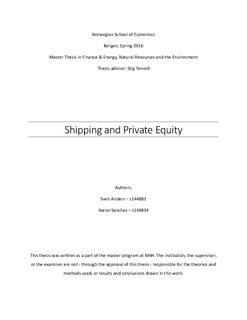Shipping and private equity
Master thesis
Permanent lenke
http://hdl.handle.net/11250/2403854Utgivelsesdato
2016-09-02Metadata
Vis full innførselSamlinger
- Master Thesis [4372]
Sammendrag
In the aftermath of the financial crisis of 2007-2008 many shipping companies had to find new
sources of financing since traditional bank lending, historically shipping’s most important form of
financing, had dried out. International trade decreased significantly and banks were unwilling to
give out substantial loans. Private equity investors and hedge funds filled part of the gap by using
their excess funds to inject both equity and debt into the shipping industry. They primarily
intended to take advantage of record low asset prices and profit from improving macroeconomic
conditions while increasing efficiency on company level. This thesis discusses to what extent
shipping is a suitable industry to invest in for private equity funds. One of the most important
factors for private equity investors is cash flow stability. In theory, cash flows in shipping are very
unpredictable due to their dependence on shipping rates, thus making it difficult for private
equity to invest. However, the correct estimation and timing of the shipping cycle can provide
certain stability to ship owners. Therefore, private equity firms have to rely heavily on proven
management teams as they lack significant sector experience and hence forecasting ability. The
asset intensive nature of the business provides some downside protection for invested funds.
The case study conducted in this thesis has found that traditional private equity methods worked
in the tanker business even though those methods are not very different from traditional ship
management practices. Out of the three levers that private equity usually applies, the financial
lever, the tax lever and the legal lever, none of those is exclusively used by private equity owners
in the shipping sector. Shipping companies traditionally use a high leverage, operate from tax
subsidized headquarters and are often private, not facing the scrutiny of public shareholders. In
shipping, private equity funds become more passive investors than they have proven to be in
other sectors. The authors present two major findings from their investigation of shipping sector
investments. The first finding is that private equity will not be able to generate large abnormal
returns on a risk-return basis in shipping since their approach is very similar to that of traditional
ship owners. The second finding is that in order to fulfill their return targets, private equity funds
have taken on increased beta risk with their shipping investments as traditionally average returns
in the shipping industry are rather low.
